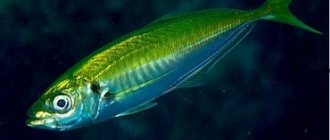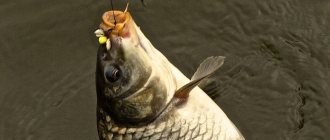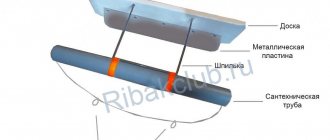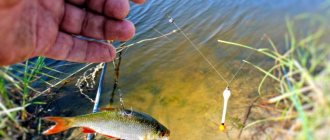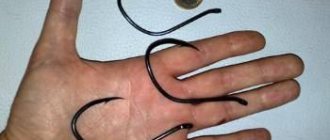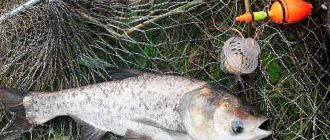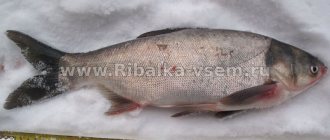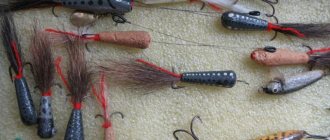Unlike most other fish, silver carp eat plant foods - this is especially worth considering when fishing. Silver carp bites in most cases begin in mid-June and end at the end of August.
During this period, silver carp are especially active. Experienced fishermen note that the bite can begin early in the morning and not stop all day.
Bait for silver carp
Silver carp are caught using technoplankton and plant baits.
Technoplankton is a compressed barrel of bait. It can be used to catch a variety of fish. It is secured using the “silver carp shelf” tackle.
If you want to learn how to make technoplankton with your own hands, you can learn about it from our article. You can also use some plant baits to catch silver carp. When approaching, the silver carp will suck them in and bite accordingly.
Let's highlight some of them:
- Polka dots.
- Pieces of cabbage or cucumber.
- Vegetables.
- Fruits, etc.
The main requirement for bait is its freshness. The bait should be firmly attached: for the most part, you have to wait a long time for a bite and a poorly secured bait will fall off the hook.
Silver carp baits can be prepared without much difficulty at home. As for plant food, everything is simple: it will be enough to break the bait into small pieces. It’s better to bait them in several parts per hook.
To make technoplankton at home you will need:
- Pea powder.
- Carp bait.
- Powdered technoplankton.
- Baby food.
- Groundbait "green silver carp".
You need to mix all the ingredients so that they are used in equal parts. To press the mixture, use a mold that you will clamp in a cleaver to compact the mixture.
Bottom fishing for silver carp (at depth)
First of all, when it comes to tackle for silver carp, it should be noted that it must be very durable. Some specimens of silver carp can reach 30 kilograms.
The gear used for catching silver carp is as follows:
- A rod measuring from 3.5 to 4.2 m.
- The reel must be inertia-free with a friction brake to reduce the resistance of the fish.
- We use fishing line 0.22-0.4.
- Hooks are selected depending on the expected size of the silver carp, but you should not use too small ones.
The main element of the equipment is the spring. This spring is clogged with bait, and you need to put pieces of foam on the hooks. This will help create good buoyancy in the leash. After the tackle hits the water, the foam swells and floats above the spring. Usually there should be no more than three leashes. The length of the leashes should be between 5 and 7 cm.
Plankton fishing
Relatively recently, fishermen had the opportunity to fish for technoplankton. In this case, it is necessary to use special equipment, which uses a sliding sinker and a barrel with technoplankton. Technoplankton dissolves in water and forms a cloudy cloud that attracts silver carp.
When fishing with plankton, the leashes float above the cloud, and this allows the silver carp to be hooked. Technoplankton contains special components that increase the appetite of fish.
In order to fish with technoplankton, you need to put foam on the hooks. This fishing method implies that the silver carp comes up to filter the clouds that have formed and is hooked. This type of gear produces pretty good results. And on some days your catch will be very significant.
Fishing with porridge
When fishing for silver carp, you can use springs and porridge to fill. It can be anything, but it is important to add at least one of these elements to it:
- Semolina.
- Vanillin.
- Cookie crumbs.
- Bran.
- Honey, etc.
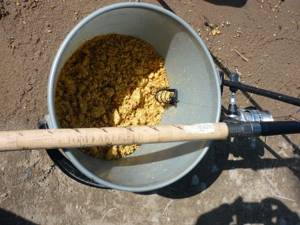
This will help add additional taste and smell to the porridge, and therefore will better attract silver carp. The porridge also creates a cloudy cloud in the water, which, due to the consistency of the porridge, will remain stable in the water.
Lure
When preparing bait, you should remember that silver carp does not like strong odors. Here are some proven recipes:
- One kilogram of peas needs to be boiled over low heat to make a puree. Then, while stirring, you need to add 100 grams of milk powder and half a kilogram of semolina. Mix until a very sticky consistency forms. It is important that the peas do not burn, this will have a negative effect.
- Prepare equal proportions of the following ingredients:
- Powdered milk.
- Breadcrumbs.
- Cake.
- A couple of pinches of dill.

Mix the above ingredients in one bowl. Prepare water in which you need to put a teaspoon of soda and citric acid. Then little by little add the resulting liquid into the container. Mix until you get a thick consistency.
We fill the spring with the finished porridge and throw it in. It is necessary to take into account that the porridge needs to be changed after each cast. This will increase the attractiveness of the resulting cloud after each cast.
When bottom fishing for silver carp, there are some nuances that are important for the fisherman to know:
- Silver carp is a rather finicky fish. Therefore, he may peck one day and not the next. If you decide to hunt silver carp, then at the same time fish for other fish. This will help you not to be left without a catch if something happens.
- Before casting the tackle, be sure to fill the feeder with bait and put foam on the hooks. If this is not done, then such fishing is impractical.
- Try to throw in the same place. This will help you feed a large number of fish in one place.
- You need to choose a place where there will be no coastal bushes, floating trees, snags, etc.
- If you use technoplankton for fishing, cover the leashes with bread crumbs. This will allow them not to get confused during the flight. In water, the bread will simply become soggy and fall off, and the leashes will level out.
Installation of bottom tackle for silver carp
The general design of the bait for silver carp is not much different from the gear for carp, with the exception of the last section with bait and hooks. Silver carp grows to large sizes, and catching a specimen weighing 10–15 kilograms is quite common in our reservoirs. So the fisherman needs to be prepared to catch a trophy and have a safety margin of gear, thanks to which he will gain confidence in his own abilities.
Rod
It is better to take a carp rod with a test of 3-3.5 Lb. This will allow you to cast the rig over a long distance and calmly fish for trophy fish, without fear that it will come off the hook or break the rod. Silver carp are also caught on feeder rods, because their carp range is also distinguished by its reliability and durability.
A soft feeder rod will give you a lot of unforgettable moments when fishing for even the smallest silver carp, and its astringent properties help to hold the fish and absorb its powerful jerks. A silver carp weighing 3–5 kg provides fierce resistance to the fisherman, not to mention specimens weighing 5 kg and above. A reliable fishing rod is the key to successful silver carp fishing and it is important to understand this.
Coil
For catching silver carp, only a spinning reel with a fast friction brake and a baitrunner system is suitable. After the hook catches the fish's lip, it most often makes a sharp jerk and tries to go into cover. An incorrectly adjusted friction brake is a guarantee of losing even small-sized fish. In addition, when approaching the shore, especially in small areas, the silver carp senses serious danger and tries to get rid of the hook.
There have been cases when a fish weighing 8–10 kg made a high candle just before the landing net and, when falling, under its own weight, broke off the equipment with a hook. Therefore, the reel is very important when fishing and close attention should be paid to its adjustment. The spool size ranges from 4000 to 6000, it all depends on the casting technique and the distance of the fishing point.
fishing line
Even when fishing with feeder rods, only monofilament fishing line is used as the base. Its stretchability plays a role, thanks to which the tackle “forgives” the fisherman possible mistakes when fishing. You cannot force the catching of silver carp, therefore, before bringing it to the net, you need to tire it out as much as possible. It’s good if the fish “grabs” air, but more often than not, it tries to go deeper and has to make serious efforts in order to succeed.
High-quality fishing line is a prerequisite when tying tackle for silver carp and you cannot skimp on it. If a hook bends or breaks under the pressure of a trophy, this is considered an unpleasant accident. But if the main line breaks while fishing or casting, it is the fisherman’s fault or his oversight. Before fishing for silver carp, always check the condition of the base and, if necessary, change it to a fresher fishing line.
The thickness of the monofilament line is 0.28-0.30. A thicker line creates inconvenience when casting, and a thinner line is unreliable when fishing for a trophy, even for experienced fishermen. It is, of course, possible to use the carp method with a shock leader and a 0.22-0.25 fishing line, but this means additional time for tying the gear and the lack of complete confidence in its reliability specifically for catching silver carp.
We knit the rig
The installation of bottom equipment for silver carp with technoplankton is tied on a piece of icecore.
For this you will need:
- trempel for technoplankton;
- a piece of ledcore with a lead core 50 cm long;
- three leashes 5, 7 and 10 cm long;
- sharp hooks on leashes 2–4 numbers according to the European classification of the wide gape shape;
- sinker on a swivel with a fastener, weighing from 30 to 80 grams, it all depends on the casting distance;
- winding ring with a diameter slightly larger than the diameter of the frame wire;
- carp anther according to the diameter of the frame.
Making a frame for technoplankton from a bicycle spoke also has a drawback, because the metal quickly rusts in water. Hungarian technoplankton producers, considered the best on the market, package their kegs with plastic frames, and it is better to use them. Plastic frames are preferable from the point of view of their lighter weight than wire, and their strength is beyond doubt.
The shape of the wide gape hooks with a wide hook ensures that when a silver carp gets into the mouth, it will hit the soft tissue. As we remember, silver carp have hard lips, and in order to pierce them, you need sharp and strong hooks with a wide hook.
No one forbids experimenting, including in choosing the shape of hooks, but wide gapes have been tested by time and many fishing trips, and these hooks will not let you down. The weight of the hooks also plays a role, because the smaller it is, the easier it is to get into the mouth of the fish, which filters the water in search of food.
Leashes for bottom tackle for silver carp are knitted from soft leash material with a breaking load of 15–25 Lb. Even when catching trophy fish, this strength of the material is enough to safely fish it out.
The color of the leading thread is not decisive, although it is better to choose calm, soft tones of black or dark green. The shape of the sinker is also not critical, although when fishing in the current it is desirable to have lugs.
But in reservoirs with stagnant water they fish with cylindrical or spherical sinkers. The weight of the load is selected depending on the type of reservoir and the distance of the fishing point. For a current you need a larger load, but for a river or a lake a very heavy load is not necessary. In any case, the weight of the load should be enough so that when the hook gets into the fish’s mouth, a self-hook occurs.
To make a bottom mount for silver carp you need:
- Using a fishhook, tie two loops at the ends of the ledcore.
- Using the loop-to-loop method, tie the icecore to the frame for technoplankton.
- Attach a sinker to the bottom ring of the trempel.
- Place a barrel of technoplankton on the trempel.
- Place a winding ring on the free end of the leadcore and stretch it all the way to the barrel, putting it on the trempel.
- Tie the shortest leash to the winding ring.
- Tie two other leashes to the side rings of the trempel.
Place the boot on the free end of the icecore and, pulling it as low as possible, fix the winding ring with the leash and the barrel of technoplankton. Before casting the bottom tackle to the silver carp, foam balls are put on the hooks and their tips are pinned into the technoplankton. This is necessary so that the leashes do not get tangled when casting. After hitting the water, the barrel begins to dissolve, the hooks are released and float up next to the barrel.
As the technoplankton erodes near the hooks, a cloudy cloud appears, which the fish comes to and, as a result, gets caught on the hook. Multi-hook rigs are not considered sporting, but catching silver carp is not a poaching activity, even though there are three hooks, not one. If you leave only one hook, the fishing performance will decrease insignificantly, but it will already be semi-sports gear.
Very rarely, silver carp are hooked with two, much less three, hooks, so they are placed more for the angler’s complacency than to improve fishing performance. But the different lengths of the leashes are important, with the shortest one knitting further than the others from the sinker. After casting, the tackle is on the bottom in a tense position, and its lowest point is the sinker. The winding ring with the leash is located on the icecore above the load and therefore a short leash is tied to it.
The length of the leashes is not constant and if there is no bite, but single “peaks” of the alarm are regularly heard, indicating that fish are nearby, it makes sense to play with the length of the leashes to solve the problem and still catch the silver carp.
When reeling out the equipment in order to refresh the technoplankton, the hooks become dull on stones and coastal debris, so be sure to check their sharpness before casting. A blunt hook, once in the mouth of a fish, will not penetrate the dense tissue, and a bite will not occur, although the fisherman does not even know about it.
Bottom rigs for silver carp with technoplankton show excellent results, but this does not mean that this fish cannot be caught with other gear. The question arises, why come up with something else if there is catching equipment? The answer is simple - the cost of high-quality technoplankton is quite high, and to catch several donks you will need a lot of it.
If you fish with a cheap and low-quality product, the results will be disastrous, so you have to think about what you can replace the bait with, but in such a way as to ensure maximum effect. As already mentioned, catching silver carp with an elastic band or hook is inconvenient, but a rig with a spring feeder will help you achieve good results if the tackle is tied taking into account the characteristics of silver carp.
The attractiveness of technoplankton as bait is due to the fact that it “gathers dust” in the water column. This means you need to make bait for the spring, which will also provide a dusting effect when wet. This bait should be inexpensive and consist of readily available ingredients, otherwise technoplankton will be preferable.
And such bait was invented by fishermen, and its main ingredient turned out to be ordinary peas, boiled to a viscous state - puree. Once in the water, pea puree begins to “muddy” the water, which is exactly what the fisherman needs. But peas by themselves will not stick to the feeder, so when cooking, corn grits and semolina are added to them.
The cooling mixture acquires the consistency of plasticine, molds perfectly into a spring and lasts a long time, gradually dissolving in water. Porridge for catching large silver carp on a spring, based on peas, has become a worthy alternative to technoplakton and is used by many fishermen. To increase the dusting effect, powdered milk is added to the bait, but even without it, the “porridge” works perfectly.
Ordinary metal springs are not very suitable for catching silver carp, but now fishing stores sell plastic spring feeders with a tremmel similar to the one used with technoplankton. It turns out that the lower part of the feeder looks like a trempel, and in the upper part, instead of a pin for attaching technoplankton, there is a spring into which the bait will be hammered.
The advantages of such plastic springs are obvious, because they:
- lighter than metal frames;
- “hold” the bait better;
- do not rust in water even after long-term fishing;
- are cheaper.
It is unlikely that you will be able to make a plastic feeder with your own hands, because this requires professional equipment such as a thermoplastic machine, but their cost is no more than that of frames for technoplankton. So, if you buy even a few feeders, you won’t deal a devastating blow to the family budget, but you will definitely be able to catch a qualifying trophy.
Anglers who fish for silver carp from the bottom still tie up to a dozen rigs with plastic feeders with springs at home, even if they are fishing with less than 5 rods. When hooked, there is a high probability of losing the equipment, and tying it directly on a pond is not very convenient.
To make an installation with a spring feeder you will need:
- a piece of ledcore with a metal core of 50 cm;
- two leashes with hooks number 4–6;
- winding ring;
- anther;
- sinker with swivel and clasp;
- plastic feeder spring.
Despite the fact that the trempel design allows you to tie three leashes, a weight is attached to the lower eyelet, and one leash is tied to one of the side ones. It turns out to be closest to the sinker, since the second leash on the winding ring is located higher.
In order to make bottom tackle for silver carp you need:
- Tie the ledcore to the trempel using a mounting needle.
- At the other end of the leadcore, make a loop to attach to the main line.
- Place the winding ring on the ledcore and stretch it to the spring itself.
- Place the boot on the icecore and, lowering it as low as possible, press the ring.
- Tie a leash with a hook to the ring.
- Attach the sinker to the lower ring on the trempel.
- Tie the leash to the side ring of the trempel.
Catching silver carp from the surface
Silver carp are caught from the surface using float gear. Let's look at the main components of the gear for this fishing:
- It is best to use carp or feeder rods. The length of the rod should be from 2 to 4.2 meters.
- The coil must be power. It will help to withstand the heavy load that the silver carp will create. It is best to use reels that are equipped with a rear drag.
- To fish from the surface you need to use a carp line with a diameter of 0.3 - 0.5 mm.
- The hook should be very strong with a medium shank size. It should not be too short and not too long.
- The float must be installed so that it can withstand this weight and stand on the water.
Catching silver carp in winter from ice tackle
There are different types of devices for catching silver carp in winter, which have their own characteristics.
A bottom feeder, as a rule, does not have a float. Suitable for catching large specimens. Such tackle should be made coarse and massive, because the fishing rod will not be used. To achieve maximum effect, you need to use a convenient location, which is calculated at a distance of six meters from each other. This method will help to completely get rid of problems when fishing is carried out during the current, since in such conditions gear often gets tangled.
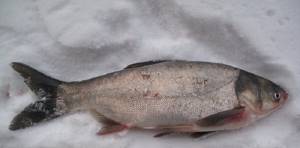
The advantage of bottom tackle is its ease of use and simple design. It also has a high level of power, which allows you to cast massive rigs and pull out huge fish. You can choose monofilament or cord, there is no particular difference. Many argue that it is wiser to choose a fishing line; it can withstand heavy loads.
The most popular is float tackle. It is good for catching silver carp. But for such equipment you will need to use a carp rod or spinning rod. You should also choose a strong fishing line 0.25-0.35 mm. This should be done according to this principle: if the water is not cloudy and free of debris, then match it to the color of the sky or the color of the water itself. The rod should be 2-4.5 m.
Silver carp always looks at the bait from below, and clear water gives it the opportunity to see the sky. At the bottom, the float, like the fishing line, should have a sky-colored color, and at the top it should be bright. It should not have a vertical position, only horizontal. Slight tilt and small size are allowed. With a fishing rod you can catch small fish weighing up to two kilograms.
Float tackle with a sliding float "Barilka". The use of a sliding float together with a load comes to the fore. This method will help secure the float and tackle from the side of the load and the rod. To make it, take a feeder tube and place it on foam plastic.
Spring feeders with a float into which bait is hammered are also widely known.
A competent choice of gear, as well as knowledge of fishing rules, will help you get trophies of impressive size.
Equipment for catching silver carp
To create equipment for catching silver carp you need:
- Thread the sinker through the main line.
- We pass two stoppers and a float through the main line.
- We tie a “trempel” to a feeder from which three leashes hang.
The result is equipment for catching silver carp from the surface.
Let us point out that there is also another option for equipment, which excludes the use of a “trempel”. In this case, place a sinker on a leash at the bottom of the feeder, and two leashes on top. This equipment is best used when fishing on a reservoir with a clean bottom.
It is best to secure these tackles on a cambric. To make it convenient to remove it if necessary. This may be necessary if you need to replace the tackle with a bottom one.
Fishing process
After the tackle has been thrown, you need to make a couple of pull-ups. Do not forget that the sinker must completely roll along the line and fall to the bottom of the reservoir. After this you need to wait for bites. Usually the silver carp comes up to filter the resulting cloud and swallows the hook.
So, when the float sinks sharply, this is a sure sign of a bite. After you have made the hook, start dragging it to the shore. Just don't do it too quickly. Better wear him out.
Nuances of fishing
- If you see that the float is tilted at an angle of 45 degrees, then this is a sure sign that the feeder is empty.
- If purchased technoplankton does not dissolve well in water, pre-soak one barrel. And when you rethrow the tackle, install it.
- If there is no bite within an hour, then it is best to re-throw the tackle. Try to throw in one place to collect more fish.
What is the best way to feed
You can prepare bait for fishing yourself. You can use finely chopped young leaves of plants, dough mixed with cake, crackers or bran. It is important that the bait includes a geyser. In this case, its fractions will begin to rise to the surface, thus attracting fish.
However, Technoplankton produced in Hungary is recognized as the best bait. It is a pressed powder in the form of small barrels. When the bait gets into the water, it dissolves, forming a cloud very similar to living plankton. "Technoplankton" is made with various flavors. The silver carp can be lured by the aroma of raspberries, anise, caramel, garlic, etc.
Silver carp killer tackle
When catching silver carp from the surface, you can use gear with a self-explanatory name – “Silver Carp Killer”. The tackle contains a large float, to which a feeder with hooks is attached at a distance of 30 centimeters. The hooks should hang below the feeder to get into the cloud of turbidity that forms in the water.
The silver carp swims up to this cloud and sucks in the mud and hooks. This rig uses a sliding sinker that is positioned above the float. The sinker is installed to act as an anchor. The float stands vertically due to the fact that the feeder pulls down.
To make such gear yourself, you need to use the following algorithm:
- We pass a sinker weighing at least 30 grams through the main line.
- We insert a stopper and a float into the line.
- We connect the fraction with a bead;
- We tie a silver carp stick, which we equip with either a spring or technoplankton. This type of tackle is a metal trempel with a welded stick from which the leashes come out. It will be enough to thread the base of the stick through the hole of the technoplankton and the tackle is ready. This stick is sold in any fishing store.
Basic fishing gear
Silver carp is a large fish that requires powerful and durable fishing gear to catch.
He simply tears thin fishing lines, and unbends small hooks. Therefore, the issue of selecting a fishing kit should be approached thoroughly. The fishing rod for silver carp is usually used as a feeder or carp rod. The main criterion is its power for landing large fish and casting heavy equipment. Typically, the length of the fishing rod is no more than 3.60 meters, and the test weight is up to 150–180 grams. Regarding its weight, this is not of fundamental importance, since it is located almost all the time on the stand.
The reel most often used is a spinning reel of carp or feeder size. An important criterion is its high-torque strength.
With such a “winch” you can safely catch silver carp weighing well over ten kilograms.
The friction mechanism of the reel is of considerable importance. It must be finely tuned to instantly dampen strong jerks of the fish, avoiding line breakage. The presence of a baitrunner is mandatory so that the silver carp does not drag the gear into the water from the stand.
Monofilament or cord? Not important. The main thing is that the breaking load of the fishing line is sufficient to catch fish. Many people still prefer braided fabric, since with the same diameter its strength is much higher than that of monofilament.
Bottom gear for silver carp makes it possible to fish by fishing the water column and the bottom layer. If the fish is at the top, then this method is ineffective, and it is better to resort to float rigs.
Let's highlight the best gear and equipment for fishing for silver carp:
- classic donka;
- donka with a fixed underwater float;
- inverted bottom with a fixed underwater float;
- with a surface float on the “silver carp killer”.
All rigs use a “silver carp killer” rig.
Classic dong
Classic bottom tackle for catching silver carp is the simplest of these options. It is easy to install directly on a pond, even for a beginner. The advantages are the possibility of ultra-long casting and the use of bite alarms of any type.
The disadvantages of the classic donka are as follows:
- The feeder or tablet of technoplankton lies on the bottom due to which it slowly dissolves.
- For the same reason, technoplankton produces little dust and does not attract silver carp well.
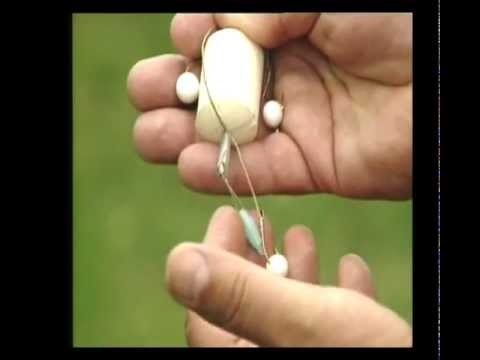
To solve this problem, you have to plant several tablets at once or use special geysers to improve dust collection. But this leads to higher fishing costs.
Donka with a float
Tackle with a fixed float involves the use of a “silver carp killer”, which is attached below the foam or wooden float. Then there are hooks on which some kind of bait is put, and a technoplankton tablet or feeder. All equipment is fixed to the bottom using a sinker placed at the end of the fishing line.
Inverted donka with float
The inverted tackle with a fixed float differs from the previous one only in that the hooks are located under the technoplankton tablet. In this case, it is advisable to put foam balls on the hooks so that they float at the level of the cloud of turbidity created.
The option of placing the float directly above the “silver carp killer” allows you to use a bite alarm, as well as easily adjust the position of the nozzle above the bottom. In addition, in this case, you can use light floats and, accordingly, small loads, which makes the tackle less noticeable and the silver carp is not afraid of it at all.
Float tackle
Float tackle for silver carp is necessary for fishing in the surface layers. It can also fish through the water column, but with less efficiency. It has the following design:
- There is a sliding weight on the main line, which plays the role of an anchor for fixing the equipment at a specific point.
- Next comes the float, which is located on the surface during fishing.
- The float is loaded with a small stabilizer weight for stability.
- Then the hooks are attached, and immediately below them is a tablet of technoplankton or a feeder.
- Additionally, at the end of the equipment you can attach a leash with a hook and nozzle.
The float can be purchased at the store, or you can make it yourself. Its optimal load capacity should be in the range of 30–40 grams. Light floats will prevent silver carp from hooking themselves, but large, voluminous floats are difficult to cast over long distances due to their windage.
The sliding weight that is used as an anchor should weigh about 45–65 grams and securely hold the rig at the fishing point. It is better to use a lead olive with a large hole to allow free movement along the line.
As a fishing rod, it is best to use a carp feeder rod 2.7-3.5 meters long, which has a test corresponding to the load. Powerful spinning rods are also quite suitable, but it is better to choose either medium-fast or medium action. Silver carp is a very strong fish; when fishing, it makes powerful jerks, so such tackle will tire the fish faster.
And here's what you need to know: Catching grass carp in the fall - On a fishing trip!
Carp fishing line 0.3-0.4 mm is used as the main line. It is better not to use a cord, since the fishing line is capable of stretching, and it will dampen the jerks of the fish. Catching silver carp from the bottom is accompanied by casting massive loads, so it is better to use a shock leader made of 0.35-0.45 mm fishing line 6-8 meters long.
A powerful spinning reel should hold at least 100-150 meters of fishing line, which corresponds to approximately 4000-5000 spool sizes. The reel must have a good drag and baitrunner. Without it, you can easily lose your tackle. When catching silver carp, the use of a landing net or hook is mandatory; it is very difficult to remove this fish from the water.
Are you interested in fishing for horse mackerel in the Black Sea? Our article will tell you and show you about this. Here you will learn how to catch barbel using bottom tackle.
Silver carp belongs to the carp family. This large freshwater fish lives in schools. It got its name due to the fact that its forehead is much wider than that of other cyprinids. And since his eyes are located at the bottom of his head, his forehead appears even larger.
It can reach a length of more than 1 meter. Certain species of this fish have a keel on their belly starting from the very throat. In addition, some species have a “sieve” - a device for filtering plankton. With this straining apparatus, silver carp also filters green, blooming water, so it is often launched into reservoirs along with a filter system.
There are two types - white and variegated. They differ in growth, color and feeding method. The diet of silver carp includes only microscopic algae, while bighead carp also adds zooplankton. This fish grows very quickly, and the motley one gains height and weight faster than its counterpart. With a length of one meter, silver carp can weigh up to 8 kg. There are individuals whose weight reaches 50 kg.
Fishing for silver carp differs by season in the choice of gear, bait and bait. Also, depending on the time of year, the fish change their stopping places.
Since it is timid and can jump out of the water quite high when there is a loud noise, fishermen can easily determine the location of the school. The frightened fish returns to its shelter again, and after some time, attracted by the bait thrown in advance, it goes closer to the surface of the water.
Silver carp is a very unpredictable fish and its behavior is difficult to predict. Therefore, any tackle, without exception, must be of very good quality. Hooks, fasteners, fishing line, swivels, fishing rods - all this must be durable. Silver carp are unlikely to behave calmly when fishing, and you need to be prepared for this.
Bottom tackle: complete set
Catching it from the bottom must take into account the fact that the fish has a special mouth structure that does not allow it to collect food directly from the bottom. He has to swim at the bottom, opening his mouth wide and filtering the water layer. Therefore, the hooks should also not lie on the bottom. To catch silver carp from the bottom, use spinning rods with a reel and bottom tackle.
Habitats
It lives in ponds, lakes, rivers and reservoirs. Prefers places where there is little or no current. Its favorite areas are those that are well warmed by the sun. This fish stays mainly in the depths and rarely comes to the surface. In general, it comes very rarely to the shore, with the exception of the morning hours, when there is an opportunity to bask in the shallows.
And here's what you need to know: Catfish fishing time - read on Catcher.fish
Closer to winter, it looks for depressions at the bottom of the reservoir and lies down in them. It reacts the same way to any rustle, noise or sound of an impact, even a passing shadow - it jumps out of the water. That is, he is particularly timid.
When to catch silver carp
What time of year to fish
- The best time of year for catching silver carp is summer. During this period he is especially active. The number of bites will be especially high during the spawning period. At this time, he is especially hungry and will try to eat more. Don't be surprised if the bites happen one after another.
- Usually the best time for biting is considered to be early morning and evening. However, in some reservoirs the bites may not stop throughout the whole day.
- Already in September, silver carp stops pecking and behaves passively. Every bite at this time is worth its weight in gold. So try to do everything right.
- In winter, silver carp are not caught. At this time, it goes deep to the bottom and buries itself in the silt.
What time of day to fish, features of fishing at different times of day
- It is best to catch silver carp in the morning and evening. At this time of day, the silver carp is looking for food. Therefore, it is best that before this time your gear is already in the water. In this case, your chances of getting a bite increase.
- During the day, the fish usually go to the bottom, and at night, silver carp bites occur very rarely. But you shouldn't neglect this. Leave one “silver carp killer” in the water.
Choosing a fishing spot
It is best to catch silver carp in those places where it was launched a long time ago. This fish usually stays far from the shore: even in the morning and evening it does not come within 20-30 meters.
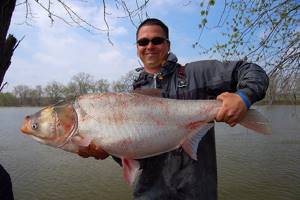
Some facts about silver carp
Silver carp is a schooling fish that feeds on microscopic algae. The average body length is 1 m. They reach sexual maturity at the age of 5-7 years, spawning is observed during the summer flood. At one time, the female lays from 490 to 540 eggs.
Habitats
Silver carp are common in the rivers of East and Southeast Asia. On the territory of Russia there are 2 types:
- white;
- motley.
Silver carp live in the Amur basin; motley representatives can be found in reservoirs located in the central or southern part of the country.
Read: Silver carp: description, nutrition and beneficial properties
When is the best time to catch silver carp?
With the right gear and bait, silver carp can be caught at any time of the year. The most active bite is observed in the morning and afternoon.
Bait for silver carp
You can feed silver carp using both purchased and homemade baits. The undoubted advantage of self-made ones is that you can adjust the composition depending on the fishing conditions. There are many bait recipes.
Pea bait. To prepare it we will need:
- 1 kg of pea porridge.
- 1 kg semolina.
- 100 grams of milk powder.
Cook the peas until they form a puree-like consistency. Remove the porridge from the stove and add dry milk and semolina. Cool the porridge and knead it until a thick mass is formed. The end result should be a dough-like mass. If there is no semolina, then you can use bran or flour.
Another fairly common recipe is the following, for which you will not need:
- Corn flour – 1 kg.
- Wheat flour – 1 kg.
- Rice flour – 200 grams.
- Powdered milk – 100 grams;
Mix everything except milk powder and pour in sweet syrup. To prepare this syrup, use sugar (200 grams) and water (200 grams). After the syrup has been added, we leave the resulting mass to soak for several hours. After two hours, pour everything into cellophane and roll it up.
This bait needs to be prepared several hours before fishing.
Blitz tips
- When buying technoplankton, try to buy a high-quality product from well-known manufacturers. Low-quality technoplankton may not dissolve in water at all, which will ruin fishing.
- Replace hooks if they are no longer in good condition. A dull hook will not be able to catch in the mouth of a silver carp.
- If bites do not occur for a long time, then change the place of fishing.
- Experiment with bait. If it doesn’t bite on one, then you need to replace it with another.
- Don’t be upset if the silver carp doesn’t quickly peck at the tackle you prepared. And catch other fish in parallel.
